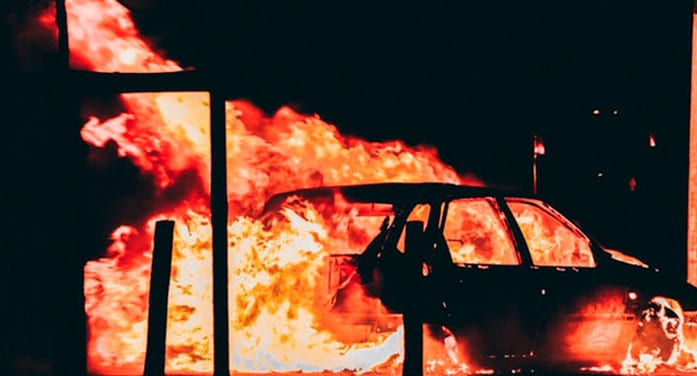With alternative media challenging the mainstream narrative, the truth about the Amsterdam riot emerged – but not without biases of its own

For interview requests, click here
One of the less-discussed causes of the First World War was the effectiveness of propaganda in demonizing the “other.” Millions of young men and women volunteered to “serve God and country” because they had fallen victim to hateful messaging perpetrated by the state and the corporate media. This disastrous war created the momentum for the 20th century to become the bloodiest in human history. Propaganda blurred reality and rallied people to destructive causes.
Have we learned anything since then? Are people in the 21st century more discerning, or are we still vulnerable to manipulated narratives?
An interesting case study that may help answer this question is the Nov. 7 football (soccer) Amsterdam riot involving visiting fans from Maccabi Tel Aviv (Israel) and local citizens. To understand its significance, it’s important to recognize how quickly corporate media and political leaders framed this incident – and how alternative narratives emerged to challenge their version of events.
In the immediate aftermath of the riot, corporate media outlets characterized the incident as a pogrom, evoking a term steeped in historical trauma. The Britannica dictionary defines a pogrom as “a mob attack, either approved or condoned by authorities, against the persons and property of a religious, racial, or national minority. The term is usually applied to attacks on Jews.” The choice of this term was deliberate and inflammatory, aiming to evoke memories of Kristallnacht, when Nazi mobs terrorized Jewish citizens in Europe. Adding weight to this narrative, the riot occurred just two days before the 86th anniversary of that horrific event.
Politicians were quick to echo this framing. Prime Minister Justin Trudeau stated, “The news out of Amsterdam last night is horrifying. This is a dark moment for our world – and one we have seen before. My heart goes out to the victims and the entire Jewish community today. Canada condemns this disgusting antisemitism.”
While such strong statements seemed justified at first glance, the emergence of alternative accounts paints a more complex picture. Raw footage and eyewitness testimonies began to surface almost immediately, contradicting the initial reports. Amsterdam residents reported being assaulted by Maccabi fans in the days leading up to the match. Footage showed Maccabi fans tearing down Palestinian flags from homes, burning them, and attacking a taxi. Inside the stadium, videos captured fans yelling and setting off fireworks during a moment of silence to honour victims of recent floods in Spain. Chants of “Let the Israeli army win and f*** the Arabs … There are no schools in Gaza because there are no children left” were also documented.
The most thorough account of the post-game violence came from a Dutch teenager who calls himself Bender. His footage showed Maccabi fans arming themselves with metal rods, wooden planks, and rocks, which they used to attack Dutch homes. Bender’s account also highlighted the disorganization of Dutch police in handling the chaos.
Eventually, young Amsterdam residents retaliated, and while their actions were primarily defensive, some included instances of antisemitism. Maccabi fans were assaulted, and the police began making arrests – though most of those taken into custody were Dutch locals. This cycle of violence, while not excusable, reveals that the incident was far more complex than the pogrom narrative suggested.
This incident raises troubling questions. Why were politicians so quick to take sides in what was essentially an episode of football hooliganism? Why was the initial reporting from the corporate media so inaccurate and one-sided? Even more puzzling, why did outlets like Sky News, which initially provided a fairly unbiased account of events, later take their reports down?
The parallels to historical propaganda are striking. In both the First World War and the Amsterdam riot, information was weaponized to shape public opinion. The intent was not to inform but to rally people to specific sides, often by appealing to emotion rather than facts. In the case of the Amsterdam riot, this approach ignored or obscured evidence that did not fit the preferred narrative.
Despite these shortcomings, this incident also highlights a silver lining: the rise of robust and effective alternative media. Platforms outside the mainstream now challenge dominant narratives, making it difficult for any one group to control the flow of information. Raw footage and on-the-ground reporting exposed inconsistencies in the initial coverage of the Amsterdam riot, forcing even mainstream outlets to adopt a more nuanced approach.
The growing presence of alternative media not only democratizes information but also fosters critical thinking. It encourages individuals to question what they are told, seek out multiple sources, and form their own conclusions.
The Amsterdam riot and its aftermath underscore the importance of critical thinking in an era of competing narratives. It’s encouraging to see people question the initial portrayal of events, examine alternative accounts, and reject the manipulation of facts for political or emotional gain. However, we must also recognize that no narrative is immune to bias. Just as corporate media deserves scrutiny, so too must alternative sources.
To create a more peaceful and informed world, we must continue to foster critical thinking. This means resisting the urge to take sides without full information, being vigilant about the motives behind those who shape narratives, and focusing on the humanity of all parties involved. If we can do this, we stand a chance of avoiding the destructive patterns of the past and building a future rooted in understanding and truth.
Gerry Chidiac specializes in languages and genocide studies and works with at-risk students. He received an award from the Vancouver Holocaust Education Centre for excellence in teaching about the Holocaust.
Explore more on Antisemitism, Propaganda, Fake news, News media
The views, opinions, and positions expressed by our columnists and contributors are solely their own and do not necessarily reflect those of our publication.
© Troy Media
Troy Media is committed to empowering Canadian community news outlets by providing independent, insightful analysis and commentary. Our mission is to support local media in building an informed and engaged public by delivering reliable content that strengthens community connections, enriches national conversations, and helps Canadians learn from and understand each other better.


